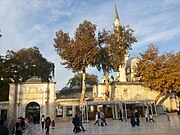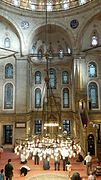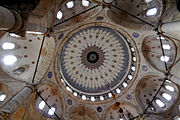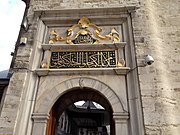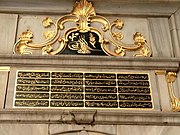Eyüp Sultan Mosque
| Eyüp Sultan Mosque | |
|---|---|
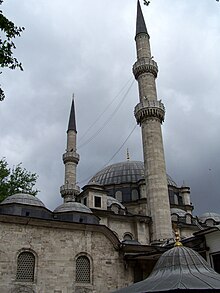 Eyüp Sultan Mosque | |
| Religion | |
| Affiliation | Islam |
| Location | |
| Location | Istanbul, Turkey |
| Geographic coordinates | 41°02′52.61″N 28°56′01.63″E / 41.0479472°N 28.9337861°E |
| Architecture | |
| Type | Mosque |
| Style | Ottoman architecture |
| Completed | 1458, rebuilt 1800 |
| Minaret(s) | 2 |
The Eyüp Sultan Mosque (Turkish: Eyüp Sultan Camii) is situated in the Eyüp district of Istanbul, outside the city walls near the Golden Horn. The present building dates from the beginning of the 19th century. The mosque complex includes a mausoleum marking the spot where Eyüp (Job) al-Ansari, the standard-bearer and friend of the Islamic prophet Muhammad, is said to have been buried.
History
A mosque complex (külliye) was constructed on the site in 1458 by the Ottoman Turks only five years after the conquest of Constantinople in 1453.[1] By the end of the 18th century the mosque was in a ruinous state, perhaps as a result of earthquake damage, and in 1798 sultan Selim III ordered the whole structure other than the minarets to be pulled down and rebuilt. This work was completed in 1800. The eastern minaret was rebuilt in the original style by Mahmud II in 1822.[2][3]

Eyüp Sultan is believed to have died during the first Arab siege of Constantinople in the 670s. His tomb is greatly venerated by Muslims. The mausoleum is on the north side of a courtyard opposite the main entrance to the prayer hall of the mosque.[3]
The mosque was the traditional site for the coronation ceremony of the Ottoman Sultans, where the new sultan was girded with the sword of Osman.[4]
Tiles
The wall of the mausoleum facing the mosque has a number of contrasting panels of Iznik tiles. They date from several different periods and were brought together during the reconstruction of mosque in 1798-1799.[5] The walls of the vestibule to the mausoleum are also covered in Iznik tiles. They have the characteristic sealing-wax red slip and date from around 1580.[5] Similar tiles to those in the vestibule are displayed in several museums outside Turkey; they probably once covered the walls of the now demolished entrance hall (camekân) to the baths.[6][7][a]
The British Museum has a panel of three blue and turquoise Iznik tiles, dating from around 1550, that are similar to some of those that now decorate the external wall of the shrine.[14][15]
Gallery
-
Entrance to the complex
-
Prayer hall and niche (mihrab)
-
Ablution fountain (şadırvan)
-
Pulpit (minbar)
-
Interior of the dome
-
Mausoleum of Abu Ayyub al-Ansari
-
Quranic verse written in Arabic
-
Ottoman calligraphy
-
The Mihrab
-
The two Minarets
-
Water Fountain
-
Water Fountain, Quranic Verse in Arabic
-
Tiles now in the Louvre in Paris
-
Tiles now in the British Museum in London
-
Gate entrance. Quranic verse written in Arabic (إِنَّمَا يَعْمُرُ مَسَاجِدَ اللَّهِ مَنْ آمَنَ بِاللَّهِ وَالْيَوْمِ الْآخِرِ): "The mosques of Allah shall be visited and maintained by such as believe in Allah and the Last Day"
See also
Notes
- ^ The Victoria and Albert Museum in London has a panel of 24 tiles,[7] the Louvre in Paris has a panel of eight tiles,[8] the David Collection in Copenhagen has a tiled panel,[9][10] and the Metropolitan Museum of Art in New York has a single tile.[11] The Calouste Gulbenkian Museum in Lisbon has a panel of 10 tiles.[12][13]
References
- ^ Sumner-Boyd & Freely 2010, p. 363.
- ^ Goodwin 1971, pp. 411–412.
- ^ a b Sumner-Boyd & Freely 2010, p. 364.
- ^ Goodwin 1971, p. 412.
- ^ a b Atasoy & Raby 1989, p. 249.
- ^ Sumner-Boyd & Freely 2010, p. 366.
- ^ a b Victorian & Albert Museum Acc. Num. 401:1 to 24-1900.
- ^ Louvre Museum Acc. Num. OA 3919/2-247e
- ^ Atasoy & Raby 1989, p. 247 fig. 477.
- ^ David Collection Acc. Num. 41/1968
- ^ Metropolitan Museum of Art Acc. Num. 64.27.17
- ^ Calouste Gulbenkian Museum Acc. num. 1709
- ^ Queiroz Ribeiro 2009, p. 119 fig. 68.
- ^ Porter 1995, p. 107, fig. 96.
- ^ British Museum Acc. Num. 1878,1230.534
Sources
- Atasoy, Nurhan; Raby, Julian (1989). Iznik: The Pottery of Ottoman Turkey. London: Alexandra Press. ISBN 978-1-85669-054-6.
{{cite book}}: Invalid|ref=harv(help) - Goodwin, Godfrey (1971). A History of Ottoman Architecture. London: Thames and Hudson. ISBN 0-500-27429-0.
{{cite book}}: Invalid|ref=harv(help) - Porter, Venetia (1995). Islamic Tiles. London: British Museum Press. ISBN 978-0-7141-1456-9.
{{cite book}}: Invalid|ref=harv(help) - Sumner-Boyd, Hilary; Freely, John (2010). Strolling Through Istanbul: The Classic Guide to the City (revised ed.). London: Tauris Parke Paperbacks. ISBN 978-1-84885-154-2.
{{cite book}}: Invalid|ref=harv(help) - Queiroz Ribeiro, Maria (2009). Iznik pottery and tiles in the Calouste Gulbenkian collection. Lisbon: Calouste Gulbenkian Foundation. ISBN 978-972-8848-58-3.
{{cite book}}: Invalid|ref=harv(help)
External links

